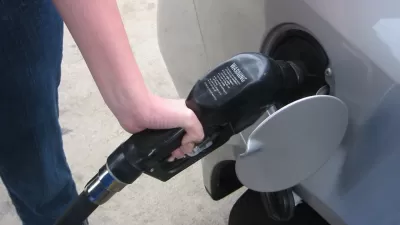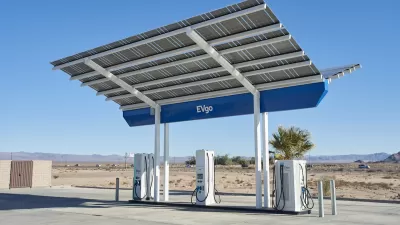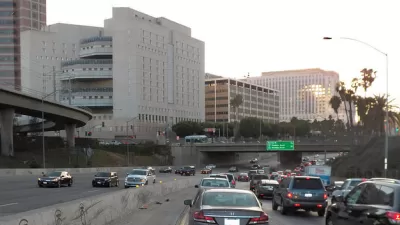President Trump made good on his promise last October to lift the E15 ban in time for the summer driving season. Not mentioned by the Des Moines Register are the downsides to allowing the higher ethanol blend to be sold during the summer, e.g., smog.

"President Donald Trump's visit to Iowa next week will include a tour of a renewable energy facility in Council Bluffs, where Trump will highlight his administration's approval of year-round access to gasoline with higher blends of ethanol," report Stephen Gruber-Miller and Donnelle Eller for the Des Moines Register on June 4.
Trump will tour Southwest Iowa Renewable Energy on Tuesday, June 11, and give remarks on the year-round E15 announcement and his administration's farm policies, the White House said Tuesday [June 4.]
The higher ethanol blend had been banned in the summer, a rule that the ethanol industry said was outdated. Gasoline with 10% ethanol [E10] is now blended in almost every U.S. gallon of gas.
Not mentioned by Gruber-Miller and Eller, nor Eller's earlier piece on May 31, were any of the many downsides of EPA's finalization of the regulatory changes to E15, gasoline blended with up to 15 percent ethanol, proposed a mere two-and-one-half months earlier on March 12, to adopt the 1-psi Reid Vapor Pressure (RVP) waiver that currently applies to E10 during the summer months.
Anna M. Phillips. an environmental policy reporter based in the Los Angeles Times’ Washington, D.C., bureau, reported on May 31 (in the source article) on the opposition to the regulation rollback coming from two stakeholders who are traditionally on opposite sides of energy issues: the oil industry and environmental and public health groups.
Jonathan Lewis, senior counsel with the [Boston-based] Clean Air Task Force, said burning higher-ethanol blends of gasoline produces more of the pollutant nitrogen oxide. This, in turn, leads to more ozone — the lung-damaging gas in smog.
California, which has some of the worst air pollution in the United States, will not be affected by the EPA’s decision because the state doesn’t allow sales of gas with 15% ethanol.
“We’re going through a process to review the environmental impacts of [the rule change] to determine if we can allow it,” said Stanley Young, a spokesman for the California Air Resources Board [CARB].
The last time that CARB looked into E15 was in 2012 at the request of the American Motorcyclist Association which opposes the higher ethanol blend "because none of the estimated 22 million motorcycles and all-terrain vehicles in use in the United States is approved by the EPA to operate on ethanol blends higher than 10 percent," states their March 29 news release on the EPA rule. And they are hardly alone. According to the EPA, E15 should not be used in:
- Model year 2000 and older cars, light-duty trucks, and medium-duty passenger vehicles.
- Engines in nonroad equipment, such as lawnmowers and chain saws
- Nonroad vehicles, such as boats and snowmobiles
The American Petroleum Institute (API), the largest U.S. trade association for the oil and natural gas industry, noted those restrictions in their May 31 news release, as well as other problems with the rule approval:
“Extending this waiver is an anti-consumer policy that risks causing costly engine and fuel system damage to nearly three out of four vehicles on the road today,” said API Vice President of Downstream and Industry Operations Frank Macchiarola. “EPA has acted outside its statutory authority in granting year-round E15 and rushed through the rulemaking process in order to meet an arbitrary deadline. This premature policy attempts to push E15 into the market before it is ready.”
"Environmental groups and the oil industry are likely to challenge the rule in court on the grounds that the EPA exceeded its authority under the Clean Air Act," adds Phillips for the Times.
Back to Iowa, the nation's #1 ethanol producer
The news of the lifting of the E15 summertime ban on May 31 was celebrated in the Hawkeye State, where state and federal leaders, including Gov. Kim Reynolds (R) and U.S. Senator Joni Ernst (R), gathered at Elite Octane in Atlantic to mark the grand opening of the nation's first new ethanol plant built in over a decade, reported Jeff Lundquist for the Atlantic News-Telegraph.
The plant can receive 140-150,000 bushels of corn per day from around 140 trucks a week and every seven days 80 railroad tankers leave the plant full of ethanol heading to refiners.
“The increased demand created by E15 will allow us to support more new ethanol plants—like the one we’re celebrating in Atlantic, Iowa today, said Ernst. "By granting the sale of E15 year-round, we’ll see an economic ripple throughout farm country, rural communities, and the entire nation.”
The only issue of concern with the granting of the 1-psi Reid Vapor Pressure (RVP) waiver allowing year-round E15 sales was, ironically, "concerns about waivers [known as 'small refinery exemptions' in the Renewable Fuel Standard (RFS) program] the EPA has provided to oil companies to avoid blending ethanol," add Gruber-Miller and Eller for the Register.
The ethanol industry says the exemptions, historically granted only to small, financially distressed oil companies, have been awarded to companies that included giants such as Exxon Mobile and Chevron Corp.
The waivers have destroyed demand for about 2.6 billion gallons of ethanol, which would require about 1 billion bushels of corn to produce, experts say.
Renewable Fuel Standard woes
The program could use major help, as Phillips colleague at the Los Angeles Times, Evan Halper, reported last year:
The Renewable Fuel Standard is starting to resemble California’s misadventures in electricity deregulation, where a well-intentioned vision spawned an oblique regulatory scheme that confused the public and invited exploitation by shrewd market players.
An interesting assessment [pdf] of the program prepared for Congress in June 2016 was written by Howard Gruenspecht, Deputy Administrator, Energy Information Administration, U.S. Department Of Energy. "The RFS program is not expected to achieve the legislated target that calls for 36 billion gallons of renewable motor fuels use by 2022," he notes from the onset. Another good analysis is noted below.
Related in Planetizen:
-
Trump Announcement Unites Big Oil and Environmentalists, October 14, 2018
-
What's Wrong With the Ethanol Mandate? February 2, 2016
-
Big Oil vs. Big Corn in Transportation Fuels Fight, February 13, 2014
FULL STORY: Trump ends summer ethanol ban meant to prevent smog

Maui's Vacation Rental Debate Turns Ugly
Verbal attacks, misinformation campaigns and fistfights plague a high-stakes debate to convert thousands of vacation rentals into long-term housing.

Planetizen Federal Action Tracker
A weekly monitor of how Trump’s orders and actions are impacting planners and planning in America.

Chicago’s Ghost Rails
Just beneath the surface of the modern city lie the remnants of its expansive early 20th-century streetcar system.

Bend, Oregon Zoning Reforms Prioritize Small-Scale Housing
The city altered its zoning code to allow multi-family housing and eliminated parking mandates citywide.

Amtrak Cutting Jobs, Funding to High-Speed Rail
The agency plans to cut 10 percent of its workforce and has confirmed it will not fund new high-speed rail projects.

LA Denies Basic Services to Unhoused Residents
The city has repeatedly failed to respond to requests for trash pickup at encampment sites, and eliminated a program that provided mobile showers and toilets.
Urban Design for Planners 1: Software Tools
This six-course series explores essential urban design concepts using open source software and equips planners with the tools they need to participate fully in the urban design process.
Planning for Universal Design
Learn the tools for implementing Universal Design in planning regulations.
planning NEXT
Appalachian Highlands Housing Partners
Mpact (founded as Rail~Volution)
City of Camden Redevelopment Agency
City of Astoria
City of Portland
City of Laramie





























